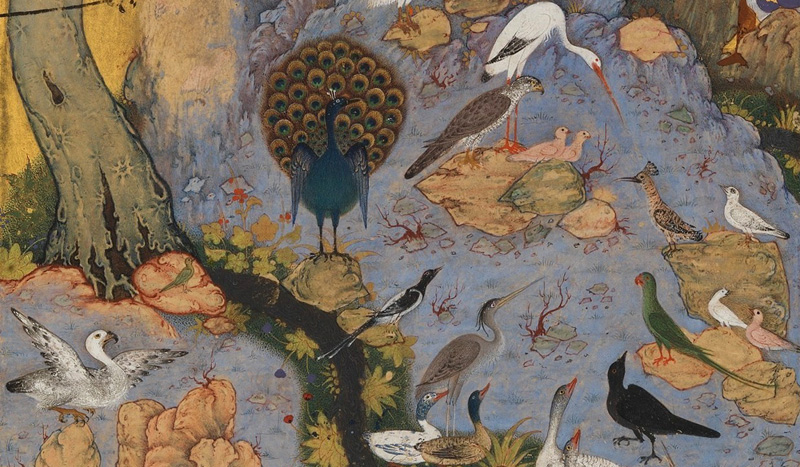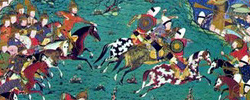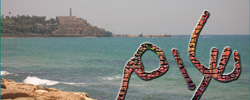DGLnotes: Notes and studies

The hoopoe instructing the other birds, in a scene from a Seventeenth-Century manuscript of Farīd od-Dīn ʿAṭṭār’s The Conference of the birds. [Source: Wikipedia]
A list of the notes and studies available on DGLnotes may be found below, sorted by subject and listed in reverse chronological order. Further materials relating to the Bahāʾī faith may be found in the Bahāʾī studies section.
Site contents
Early Islamic civilisation
During the Arab-Muslim conquest, numerous tribesman from Arabia settled the fertile land of central Iraq. A collection of reports regarding the specific case of the tribe of Bajīlah provide an opportunity for studying the narrative development of Islamic historiographical literature. This article presents primary source literature relating to the Bajīlah’s land claims.
The Battle of al-Qādisiyyah during the Arab-Muslim conquest of Iran in the 630s has since taken on a reputation of legendary proportions and its image today highlights the function of history and memory in the modern Middle East. From Ṣaddām Ḥusayn (Saddam Hussein) to al-Qāʿidah, Qādisiyyah is exploited for political uses, and the frequency of its nomenclature throughout the Muslim world exemplifies its continuing emotive power.
Modern Middle East
Radical Islamists hearken often to events, figures, and symbols from early Islamic history in their recruitment and mobilisation efforts. This short study examines the radical rhetoric regarding the Battle of al-Qādisiyyah and the imagined heroïne and rôle model al-Khansāʾ as examples of how radicals reinterpret history to further contemporary interests.
The choice by Ṣaddām Ḥusayn (Saddam Hussein) to call his eight-year war with Iran ‘Ṣaddām’s Qādisiyyah’ was a deliberate effort to hearken back to the Seventh-Century Battle of al-Qādisiyyah during the Arab-Muslim conquest of Iran. This short study examines Ṣaddām’s manipulation of the memory of al-Qādisiyyah and how this discourse reflected an ‘Arab-Islamist’ idiom that allowed him and his régime to fuse religious and nationalist sentiment into one ideological discourse.
Central Asia
Tajiki identity caught between Iran, Islam, and Russia, 11 May 2014.
The Republic of Tajikistan came into being in late 1991 as a state with no historical precedent. Emerging from decades of secular Soviet political and cultural control, cut off from the Tajik heartland of Bukhōrō and Samarqand, and facing a potent challenge from a charismatic Islamist movement, the country faces a great need to construct a cohesive and durable national identity. Several options were and are available to the leaders of the country: an embrace of Iranian ethnic roots, a return to the Islamic tradition that had defined the region in in the pre-Soviet era, or a continuation of the pattern of Soviet society and civil religion. While any one may appear a logical choice, each path brings with it certain hazards. This article discusses these various identities available to the Tajik leadership and how the country has navigated a careful balance between them.
Language and linguistics
The revival of Hebrew in recent times provides an interest case study of one language’s influence upon another. There are many similarities between Israeli Hebrew, on the one hand, and Modern Standard Arabic and Levantine Arabic, on the other. What are these similarities and what conclusions can we draw from them about the extent and manner of Arabic’s impact on Hebrew?
Other notes
Transliteration is the process whereby the text of one alphabet is converted into that of another. Within the realm of Western scholarship on the Middle East, transliteration is essential in order to represent characters, words, and phrases from Arabic, Hebrew, Persian, and other languages. Here are several transliteration tables for these languages as used on DGLnotes and in leading academic and scholarly publicatios and resources, along with links to other transliteration schemes.
Upcoming talks and lectures
Please note that not all of these events are open to the general audience; please check with the organisers to confirm.
09 September 2025—‘Category imperative: Establishing a Bahāʾī department in the Israeli Ministry for Religious Affairs’ (41st annual meeting of the Association for Israel Studies): Haifa, Israel.
01–03 November 2025—‘“The Arab-Israelite conquest”: Biblical models and the historiography of the Arab-Islamic expansion’ (18th annual conference of the Association for the Study of the Middle East and Africa): Washington Georgetown Marriott Hotel, Washington, DC.







